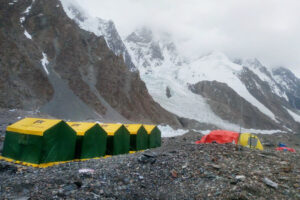Nanga Parbat and K2 are the only 8000ers never summited in winter.
In 2015 Elisabeth Revol and Tomasz Mackiewicz had to turn around only 300 meters from the summit of Nanga Parbat. Almost exactly one year later they are at 7200 meters ready for another summit push.
Nanga Parbat is one of only two +8000 altitude peaks left on the planet to gain a summit in winter. This is also the mountain that cost the lives of 11 climbers killed by terrorist radicals some years ago.
But the current attempt is remarkable even in other aspects.
Check updated winter stats at www.adventurestats.com.
44 winter summits – one by a woman
Of the 14, 8000er meter mountains on Earth, 12 have now been summited during winter. 43 of the summits were made by men and only one by a woman. On Feb 10, 1993, 30 years ago Swiss Marianne Chapuisat summited Cho Oyu in an international expedition.
Polish mountaineers dominate the statistics.
1980 – 1994, the golden days of winter climbing
The first 8000er summit was made on Feb 17, 1980 by Wielicki and Cichy. Wielicki also made winter summits of Lhotse and Kangchenjunga.
The late Jerzy Kukuczka holds the record with two full winter expedition summits and two partial winter expedition summits.
2005 – , winter climbing renaissance
After 10 years without a winter summit, Italian Simone Moro stepped up as the new leader of winter climbing with three full winter summits between 2005 and 2011, two of those with Russian Denis Urubko.
Maciej Berbeka – timeless
Berbeka is the only climber to summit a winter 8000er during the golden age and the renaissance. In 1984-85 he made the first winter summits of Cho Oyu and Manaslu. 29 years later he was part of a Polish team to make the first winter ascent of Broad Peak, but was tragically lost on the descent.
Definitions
According to the rules at Adventurestats, to classify as a full “winter expedition” the ascent (including on mountain acclimatization and preparation) has to be done during calendar winter (Dec 21 to Mar 21). If the expedition started out before Dec 21, but the actual summit was within calendar winter it is considered a “winter summit”.






